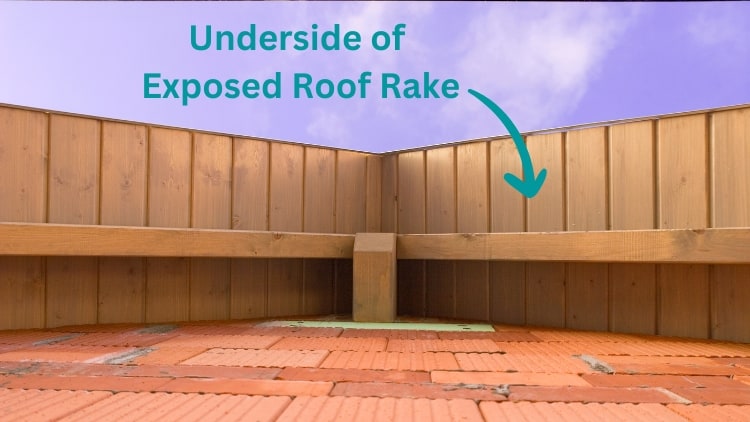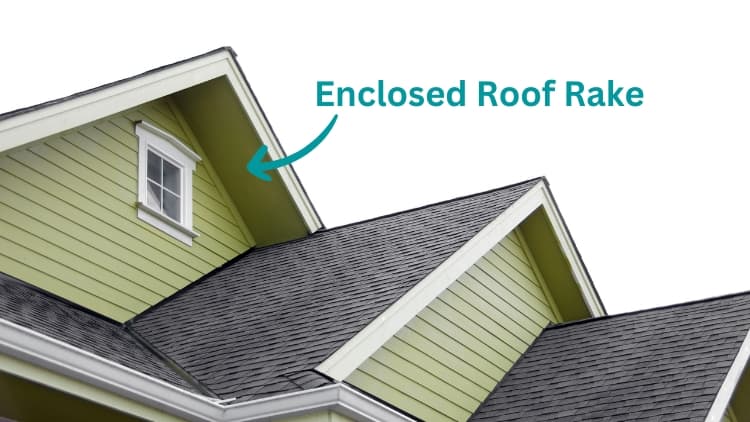Sloping from one end of the building to the other, a roof’s rake adds tremendous value to a building. It adds form and function, transforming an ordinary-looking home into something special. The rake also provides shadows as well as highlights the architectural treatments that may have otherwise gone unnoticed.
What is a Rake Roof?
A rake roof is the portion of a roof that extends past the exterior wall at the gable end of the roof which spans from the eave to the ridge. Instead of stopping at the edge of a roof at the exterior wall where potential leaks can occur, the rake roof extends past the wall providing additional protection.

In construction, the rake of a roof, or what some other people call the roof rake, is essential for both function and aesthetics. This shouldn’t be confused with a roof rake, which is what we also call the tool used to clear off a roof from snow and ice.
The roof rake has always been a part of any gabled roof. It’s the gable side of a roof, cutting across its length and extending from ridge to eaves.
Depending on the climate and other environmental conditions, the materials used will influence the slope of the roof rake. For example, it’s common to have a higher pitch in snow-prone climates so that snow slides off more easily. Conversely, a shallower slope may be enough in dry climates where little rainfall occurs.
What is the Difference Between a Roof Rake and a Roof Eave?
Both a roof rake and a roof eave are essentially the same thing, an extension of the roof past the exterior walls. However the main difference is its location.
The roof eave is an extension of the roof rafters that overhang the exterior wall while the roof rake is an extension of the roof at the gable end.

Therefore the roof eave is found on the sloping side of a roof and the roof rake is on the gable side.
It might not seam like it but a roof have various parts. There’s the ridge, gable, rake, fascia, eave, soffit, and many more. It’s important to have an understanding of roof elements. Knowing the anatomy of a roof and its terminology is important.
What are the Different Types of Rake Roofs?
As mentioned above, a roof rake is commonly seen in homes with a gabled roof structure. However due to different architectural styles and forms a roof rake can look somewhat different. Here are a few different types of rake roofs you can find on a home.
1. Exposed Rake Roof
Typically the rake portion of a roof will match the eave overhand. When roof rafters that extend beyond the exterior walls and are exposed, the rake portion will be exposed as well. One of the advantages of this type is that the rake roof is lightweight.

Due to it generally being lightweight, this type of rake roof can extend far past the gable end when properly supported which can provide a great architectural feature in certain types of architectural styles such as a craftsman home for example. However, since it is exposed, it can take more damage from wind and weathering than the other two types of roof rakes discussed here.
2. Boxed In Rake Roof (Enclosed)
A boxed in rake roof at the gable end can mean an extra layer of protection against outside elements such as wind and rain. This type of rake is used in homes with hip roofs and can be integrated into existing architecture easily. There are other benefits to boxing in a rake roof other than protecting it from the elements.

In some cases it might be required in certain geographical areas when a structure is located in an area designated as a high fire zone. Boxed in eave and rake can provide a level of protection when certain types of materials are used.
What are Some Common Problems with Roof Rakes?
While the rake of a roof can provide both aesthetics and function, there are some things to be mindful of to help you rake roof last a long time. Many issues and problems that can arise if the rake of a roof is not properly maintained.
1. Moisture
Although roof rakes help to keep water away from the walls, moisture can build up, in boxed roof rakes for example, when not properly sealed. When this happens, the rake supports can get damaged by moisture.
When rain, snow, and high humidity come into contact with a poorly maintained or worn-out rake boards, the materials in the board can absorb moisture and become damaged. Additionally, mold growth is also possible due to this kind of moisture being trapped inside an enclosed roof rake.
2. Rotting and Deterioration
Similar to the above, roof rakes can also rot or deteriorate over time due to exposure to the elements. This is especially true when it comes to exposed roof rakes. As mentioned earlier, moisture buildup is a common problem with a roof rakes. Leaving it exposed to rain, snow, and humidity can cause it to rot or deteriorate.
If your rake boards are constantly exposed to rain and snow, they may start to warp or lose their structural integrity. This can result in sagging facia boards rake boards.
3. Safety and Stability
A common misconception out there is thinking the roof rake is just as strong and stable as the roof eaves. While the roof eave is an extension of the roof rafters themselves, which support the roof, the rake roof is only supported by small outriggers that are aimed at supporting only a facia board.
The reason this is important to mention is at times of examining the roof it is good to take note for any roofer or homeowner not to stand or reply on the rake end of a roof for support. Standing on or near the rake end of a roof have be very dangerous and should be avoided since it does not have any structural integrity other than maybe just supporting the small facia board itself.
Different Maintenance Tips to Take Into Account
In order to keep your roof rake in good condition and avoid any of the above issues, it’s important to take preventive measures and practice regular maintenance.
A roof inspection at least once a year can help detect any potential problems that your rake boards might have, so you can take measures to repair them before they become an issue. Roof inspections can help to uncover issues you might not be able to see for yourself.
You should also make sure to keep the roof rake clean of debris and leaves by regularly clearing them out. This will help keep your roof free of water damage. Lastly, you may want to consider applying a sealant or weatherproofing material to the rake board to help protect it from the elements and extend its life.
Final Thoughts
The rake of the roof is an important component of the overall structure, and it’s essential to keep it in good condition. Getting a yearly roof inspection, at the very least, is a must, and doing regular maintenance can help prevent any potential issues from developing. If you ever need to repair or replace your roof, call a professional. It’s tempting to do things on your own, but it’s best to leave important tasks like this to the experts.
